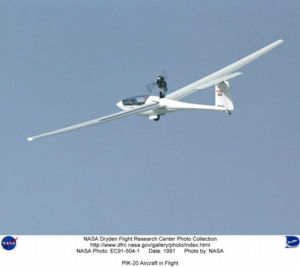PlaneSpottingWorld welcomes all new members! Please gives your ideas at the Terminal.
Eiri-Avion PIK-20
| A self-launching PIK-20E at the Dryden Flight Research Center. | |
| Type designation | PIK-20 |
| Competition class | Standard but later 15 metre |
| Number built | 425 + |
| Crew | 1 |
| Length | 6.43 m |
| Height | 1.34 m |
| Cockpit width | 0.60 m |
| Cockpit height | 0.86 m |
| Wingspan | 15 m |
| Wing area | 10 m² |
| Aspect ratio | 22.5 |
| Wing profile | Wortmann FX 67-K-170 |
| Empty mass | B 235 kg C 210 kg D 225 kg E 290 kg |
| Maximum Water ballast | B 140 kg |
| Tail Water ballast | N/A |
| Maximum mass | 450 kg |
| Wing loading | B 32.5 - 45 kg/m² D 28 – 45 kg/m² E 28 - 45 kg/m² |
| Maximum speed | 262 km/h |
| Rough air speed | 242 km/h |
| Maneuver speed | 185 km/h |
| Stall speed | 60 km/h with 90º flaps @ 320 kg |
| Minimum sink rate | B 0.66 m/s (2.16 fps) |
| Best glide ratio | B 42:1 at 110 km/h (63 kt) |
The PIK-20 is a Standard Class sailplane designed at the Helsinki University of Technology by Pekka Tammi, with advice from Ilkka Rantasalo and Raimo Nurminen. The prototype first flew in October 1973. It was produced initially by Molino O/Y who were taken over by Eiri-Avion O/Y between 1974 and 1980.
The first models were notable for using flaps instead of air-brakes for approach control. The specification of the Standard Class required full air-brakes capable of keeping the speed below the maximum speed in a vertical dive. However at high speed great force was needed to lower the flaps and so a geared crank handle was used. At the time the PIK-20 conformed with the rules for Standard Class because the flaps could only be used for landing.
The first prototype finished 13th in the World Gliding Championships in Waikerie in January 1974 but it performed impressively. (The low placing was caused by a poor decision on the first day of the competition.) The glider was then produced at the rate of two to three per week.
The rules of the Standard Class were changed again to allow the flaps and ailerons to move together (flaperons) and for intermediate settings of the flaps between landing mode and zero. The result was the PIK-20B which won British, American and Finnish National Championships in 1975. In 1976 Ingo Renner won the World Championship with a PIK-20B and second and third places were also taken by this type. Most owners of PIK-20A converted to the B's flaperon arrangements. Carbon fiber spars later became standard.
Another change in the Standard Class rules prohibited flaps completely. As a result the D was produced for the new 15 metre class. This had conventional Schempp-Hirth airbrakes, carbon reinforcement strips at critical locations in the fuselage, the nose profile was sharpened, the tail-plane was moved forward and fuselage fairings recontoured to reduce drag. The first flight of the D was in 1976.
The self-launching PIK-20E had a retractable Rotax 501 that took 15 turns of a manual crank in the cockpit to deploy or retract. The fuselage was slightly different, there was a slight sweep-back of the wings and the tailplane was larger. The Issoire Company in France produced a 17 metre PIK-30 version of the E.
A PIK-20F had a modified wing profile, reshaped fuselage and a forward opening canopy.
The PIK-20s were also notable for being conventionally painted rather than using gel-coat. (The prototype was bright yellow.) This type of finish is longer lasting and simpler to repair.
The name PIK is an acronym for Polyteknikkojen Ilmailukerho, the flying club of the Student Union of Helsinki University of Technology.
A fire in the factory June 1977 dented production briefly but by then 200 gliders had been sold. Production continued until about 1980 with the D and E versions with over 400 20's of all types made.
Sources
- Johnson R, A Flight Test Evaluation of the PIK-20, Soaring, September 1976
Johnson R, A Flight Test Evaluation of a PIK-20 Sailplane - A Further Evaluation, Soaring, July 1978 and August 1978
Johnson R, A Flight Test Evaluation of the PIK-20D, Soaring, January 1979 - Thomas F, Fundamentals of Sailplane Design, College Park Press, 1999
- Simons M, Segelflugzeuge 1965-2000, Eqip, 2004
- Sailplane Directory
Lists relating to aviation | |
|---|---|
| General | Timeline of aviation · Aircraft · Aircraft manufacturers · Aircraft engines · Aircraft engine manufacturers · Airports · Airlines |
| Military | Air forces · Aircraft weapons · Missiles · Unmanned aerial vehicles (UAVs) · Experimental aircraft |
| Notable incidents and accidents | Military aviation · Airliners · General aviation · Famous aviation-related deaths |
| Records | Flight airspeed record · Flight distance record · Flight altitude record · Flight endurance record · Most produced aircraft |

